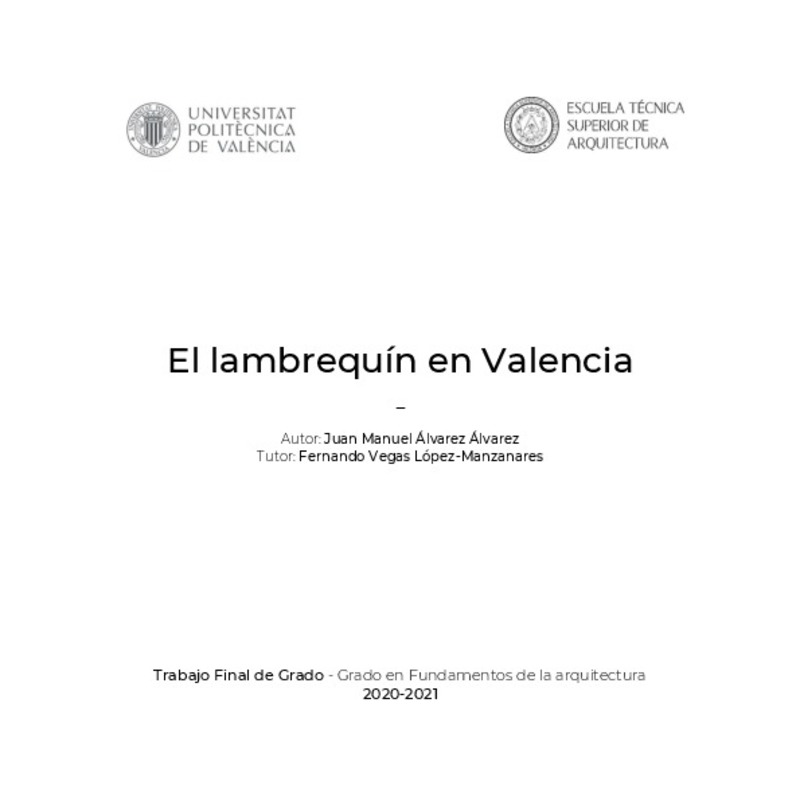|
Resumen:
|
[ES] La principal motivación del presente trabajo nace de la necesidad de dar a conocer y poner en valor el lambrequín en Valencia.
El control del asoleamiento a lo largo de la historia ha sido un desafío al cual la ...[+]
[ES] La principal motivación del presente trabajo nace de la necesidad de dar a conocer y poner en valor el lambrequín en Valencia.
El control del asoleamiento a lo largo de la historia ha sido un desafío al cual la arquitectura ha procurado dar diversas soluciones para satisfacer el confort de las personas que la habitan.
El lambrequín, también conocido como guardamalletas o guarda persianas, es un elemento arquitectónico que se ubica en la zona superior de los huecos de la fachada coronando la persiana veneciana exterior y cuya existencia se debe a ella. Está realizada fundición, forja y carpintería, entre otros. Tuvo su máximo apogeo en el último cuarto del siglo XIX.
El lambrequín cumple dos finalidades; una funcional, protegiendo el mecanismo de la persiana de la climatología, en mayor o menor medida, y otra estética dado que ocupa su lugar en la fachada. Valencia es la ciudad española con mayor número y variedad de lambrequines de esta tipología.
Por lo tanto, en el presente trabajo se realiza un estudio de su contexto histórico y ámbito geográfico y los diferentes tipos que existen según su material y estilo, además se analiza como caso de estudio los lambrequines de la calle de la Paz de Valencia, constatando la riqueza y expresividad artística que abarcan.
En la actualidad el lambrequín no cuenta con ningún nivel de protección lo que conlleva la desaparición progresiva de los mismos. En definitiva, con el presente trabajo, se pretende dar a conocer el lambrequín y su papel en la aportación de la riqueza arquitectónica como elemento singular de la arquitectura local de la ciudad de Valencia.
[-]
[EN] The main motivation of the present work born from the need to make known and highlighting the lambrequín in Valencia.
The control of sunlight throughout history has been a challenge to which architecture has tried ...[+]
[EN] The main motivation of the present work born from the need to make known and highlighting the lambrequín in Valencia.
The control of sunlight throughout history has been a challenge to which architecture has tried to provide various solutions to satisfy the comfort of the people who inhabit it.
The lambrequin, also known as lambrekin, is an architectural element that is located in the upper area of the gaps in the facade crowning the external Venetian blind and whose existence is due to it. It is made foundry, forging and carpentry, among others. It had its peak in the last quarter of the 19th century.
The lambrequin fulfills two purposes; a functional one, protecting the shutter mechanism from the weather, to a greater or lesser extent, and other aesthetics since it occupies its place on the facade. Valencia, is the Spanish city with the greatest number and variety of lambrequins of this type.
Therefore, in the present work a study is carried out of its historical context and geographical scope and the different types that exist according to their material and style, in addition, the lambrequins on calle de la Paz in Valencia are analyzed as a case study, validating (noting) the richness and artistic expressiveness they includes.
At present, the lambrequin does not have any level of protection, which leads to their progressive disappearance. In conclusion, with this work, the aim is to make the lambrequin known and its role in the contribution of architectural wealth as a singular element of the local architecture of the city of Valencia.
[-]
|







